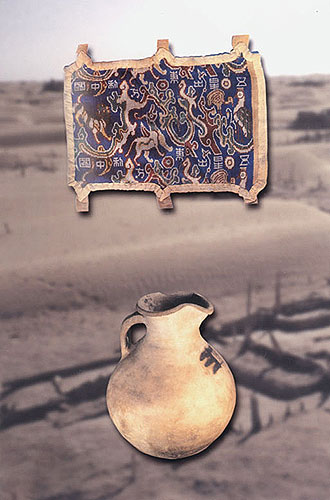| Art Q&A > Archeology |
|
|
Site of Niya
Site of State of Jingjue from the Han Dynasty (206BC-220AD) to the Jin Dynasty (265-420)
Location: Minfeng County, Xinjiang Uygur Autonomous Region
Period: 2nd century BC-5th century AD
Excavated from 1959 to the present
Significance: It has supplied precious materials to the study of the relationships between the empire located in the Central Plains and ancient kingdoms in the Western Regions, which covers the area of the present-day Xinjiang and parts of Central Asia. It is also of great importance to the study of the cultural exchanges between the East and the West, as well as the Silk Road.
In the Site, the ruins of foundation of houses, courtyards, tombs, stupas, temples, fields, orchards, channels, kilns, and smelting workshops, etc., have been excavated, together with a large quantity of cultural relics, including wood ware, bronze, pottery, stone ware, woolen articles, coins, etc.
In 1959, a wool pile carpet fragment was unearthed at the site of Niya, China, on the southern edge of the Taklamakan Desert found along the Silk Road. The fabrication of the fragment discovered has been dated back to about 100 BC. The Niya Site is one of the most important archaeological sites in Tarim Basin and is actually the site of Jingjue Kingdom in the Han Dynasty and during the Wei and Jin period.
No one can believe that there was a rich and varied community that once thrived deep in today's Taklamakan Desert some 1,600 years ago. Just like other places in China, it was then under the control of several officials appointed by the central government. There lived more than families with a population of more than 3,000 people. Sprawling over an area 20 km in circumference around what is now the dried bed of Niya River, however, the city eventually became buried in the desert sand and slipped in oblivion. The extinction of Niya has left archaeologists and scientists many questions to answer. It has also given the ruins of the ancient holy city a feeling of mystery.
The Niya River winds through the southern Taklamakan Desert for about 210 km and its head waters are fed by melted snow from the towering the Kunlun Mount, known was Nanshan Mountain in ancient times. The river gradually dries up near a small Uygur village.
The city's ruins were lost until the early of the 20th century, when the British explorer Sir Aurel Stein discovered the ruins and archaeologists have continued their exploration of the area ever since.
Eight tombs have been discovered at the northern part of the ruins. Some of them were already exposed when they were laid out in hollowed out logs or wooden trunks with an outer coffin. Dried out by the deserts heat and virtually undisturbed, the bodies, clothes and burial articles are in excellent condition.
The details of the brocade show exceptional care. The edge of the silk hasn't been unraveled and the fabric still has its original luster. Even the green and yellow, colors which easily fade, are preserved. Pieces of brocade, much less in quantity and variety, were found in Niya in 1959, with three motifs: animal patterns, geo-metric designs and auspicious tokens, all of which have never been encountered before.
Among the burial articles is a place of food with mutton, pears, and grapes. This variety serves as evidence of oasis agriculture and livestock raising. |
||||
All rights reserved. Reproduction of text for non-commercial purposes is permitted provided that both the source and author are acknowledged and a notifying email is sent to us. |
||||
 |
 Introduction
Introduction
 History
History Cultural Heritage
Cultural Heritage